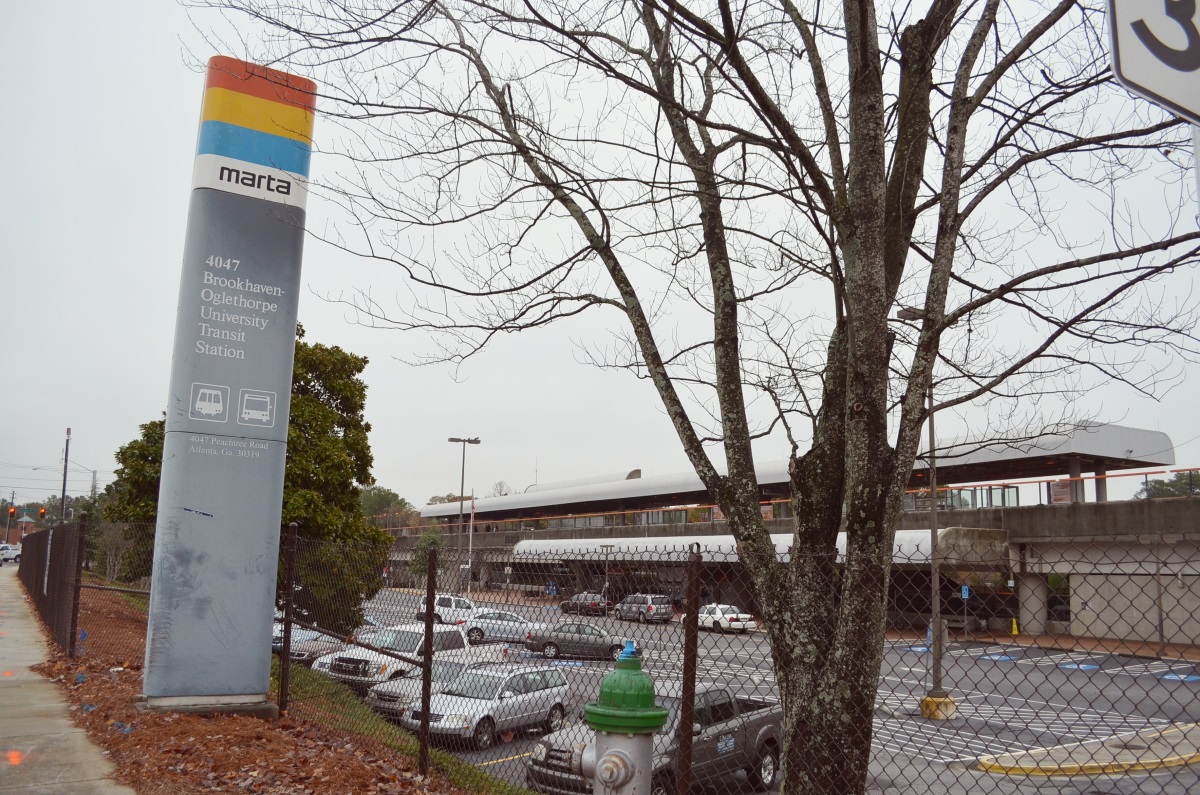MARTA Builds For New Riders, But Some Fear Effect On Traffic

MARTA is eyeing several stations around the region for new ”transit oriented developments” aimed at boosting ridership. The project at Brookhaven’s station has faced skepticism from some in the surrounding community.
Don Green watches cars line up at a Brookhaven intersection just across the street from the Brookhaven/Oglethorpe University MARTA station.
The agency is eyeing 15 acres of parking spaces around that rail stop for one of its new “transit oriented developments” — sometimes called TODs — and Green is worried.
“It’s a traffic oriented disaster,” Green said. “It’s just going to be miserable at rush hour in the morning and the afternoon.”
Green said the roads in Brookhaven won’t be able to handle the kind of density MARTA’s proposing: a mixed-use project for residences and businesses, including a park and hotel.
“It’s bad enough around here already,” Green said. “They’re going to add, you know, 200,000 square feet of office space and over 500 apartments or homes in that little footprint. And where are the people going to go?”
The project is part of a recent effort from MARTA that’s partially aimed at increasing ridership. The idea is to transform underused parking lots around some of its stations into development hubs, and basically build new riders into the rail system.
But the agency’s real estate plans are running into skepticism from people, like Green, who live around these stations. He doesn’t believe people will actually take transit over cars. MARTA, he said, isn’t convenient.
So the agency’s up against a question as it works to get these projects off the ground: Will the transit oriented developments actually generate new passengers or just more traffic?
“Inevitably with our project in Brookhaven, it will create some new traffic,” said Amanda Rhein, Senior Director of Transit Oriented Development and Real Estate at MARTA. “But a high percentage of those people will use MARTA.”
Rhein said their model for the Brookhaven development estimates a quarter of all trips will be transit. Although she said she believes that’s very conservative, MARTA can’t prove otherwise until complexes like the one in Brookhaven are built.
“But we’re doing everything within our power to ensure that if somebody does move there, they’re given every reason to at least try transit and make that switch in their commute or whatever their daily activities are,” Rhein said.
One plan MARTA is considering is to give residents breeze cards, she said, while another is to partner with employers that have office space at developments.
In a sense, though, MARTA just has to ask nearby communities to have faith.
And even some transit supporters say they see why believing might be hard. Matt Garbett, an advocate and co-founder of a group called ThreadATL, which promotes urbanism in Atlanta, looks around the apartments at Lindbergh station.
“The amount of parking dedicated to this development is staggering,” Garbett said.
MARTA built its first and last transit oriented development here more than a decade ago. Garbett said, it gives so much space to cars that it’s basically “transit optional.” And that doesn’t do much for congestion.
“Because people are going to opt into the car most of the time,” Garbett said. “Unfortunately, on an individual basis, using a car will probably be more efficient for a lot of people, and they’re going to make that decision. Unless you build a better environment around it.”
That means building a development that sways people to choose transit not for a few trips a week but nearly all trips.
MARTA said it has put in place new development guidelines since Lindbergh, and that, even after all these
”At this point, TOD is really an unproven concept in Atlanta.”
years, the development is still not finished. The agency recently started plans to implement the second phase of the project.
But MARTA still faces a big obstacle when it comes to reducing parking, according to Rhein. Banks won’t finance projects, even ones designed around transit, without it. That’s even though national studies find that the developments tend to include more parking than is necessary.
“At this point, TOD is really an unproven concept in Atlanta,” Rhein said. “So I think for future projects, if we’re able to demonstrate that we are in fact over parking, then there would be some willingness to consider a reduction.”
Overall, Rhein said, MARTA needs good examples to point to that show the developments can be an asset in a region built for cars.
The agency has been stuck in the planning phase at the Brookhaven site, as the local city government decides whether it will rezone the land for the project. At stations in Atlanta’s Edgewood neighborhood and near Avondale Estates, however, MARTA has already kicked off construction for TODs.
If the agency proves the projects are successful, the payoff won’t just be the revenue from leasing the land or getting more riders, she said.
“I think part of the positive effect that these projects will have is somewhat intangible and that’s just changing how people perceive MARTA,” Rhein said. “And just give more people an opportunity to actually use the system in a way that’s a better fit with their lifestyle.”
She said, the result of that is for people to see rail stations as destinations, for restaurants or their own homes, and MARTA as a convenient way to get them there.








